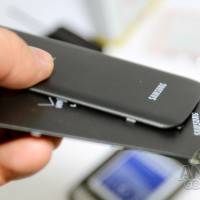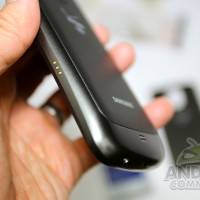
Smartphones still aren’t most the power efficient of gadgets, and LTE radios gobble up battery power even faster. Though the Verizon LTE Galaxy Nexus already features a larger battery than its HSPA+ brother, no doubt a few of you will already have your new phones begging for more juice long before the day’s over. Enter Samsung’s extended battery, which give the Galaxy Nexus a slightly extended 2100mAh of power. That’s an increase of 250mAh – not a gigantic addition, but it’s also not going to give your new phone a tumor on its back.
The extended battery does require a new battery cover, but given the only slightly increased depth, it doesn’t dramatically affect the slim profile of the Galaxy Nexus. The extended cover kind of smooths out the angled edge where the bottom of the cover meets the “Galaxy hump”, giving the extended version a more rounded and smooth appearance. We didn’t have any calipers handy for the video below, but I’d say that it probably increases the thickness of the Galaxy Nexus by less than 2 millimeters. We’ll have some extensive battery testing in our upcoming review.
We also tested out the standard battery with Samsung’s extra battery charger and a rudimentary screen protector. There’s no surprises here, except perhaps that the extended battery slides into it without any issues. It doesn’t close, but it charges fine. At least some Verizon stores are running a promotion, wherein you can get 20% off of accessories if you buy three at once. We haven’t seen any sort of promotion for this, so it may be limited, though reports out of both Texas and Arizona indicate that you can get the deal there. Both instances were corporate-owned Verizon stores, not second party resellers.
[device id=1740]
















Is your statement about the screen being scratched easily based on anything? I know it’s not Gorilla Glass, but it is fortified and I was under the impression (I think I saw a scratch test video a while back) that it was basically scratch-proof.
I hope so because I hate screen protectors.
http://www.youtube.com/watch?v=uyLC61JxsJQ
this video (unless faked) makes it look like the GN screen is pretty scratch resistant.
Thanks for the video – I have been looking at accessories!!
I’m very curious as to which app he is using to make the LED notification blink so fast.
probably this:
https://market.android.com/details?id=com.rageconsulting.android.lightflow&hl=en
nm. it locked my screen in the off position. had to adb reboot and uninstalled. crap.
I’m so glad I checked the comments before I hit the “install” button….
WOW
Yea it did the same to my phone. Started doing it when I started the LED Test feature. Uninstalled, then reinstalled and working great. Just don’t hit the test feature lol. Great App, don’t let the one shortcoming keep you from installing it 🙂
Ok… a bit of experiment tells me that it’s app dependent. Missed call, gmail will trigger a blink that has a very long delay in between blinks, but Google Voice will have the LED blink green every 3 sec. or so.
I was offered 20% off 3 accessories and 30% off 5 at purchase of my GNex. This was in Northern California.
One thing I noticed with the anti-glare shield. I installed it on my nexus, but not on hers. I then discovered that my phone’s reception was worse than hers by 20dBm. Removing the anti glare shield restored the signal strength to be the same. This actually made the difference between getting reception and not getting any reception. That said, the signal strength is still not great.
Snuffle if you installed the 4.0.2 update that could be what’s making your signal strength low. Many people who downloaded the 4.0.2 update are experiencing signal problems. I learned this from – http://androidcommunity.com/verizon-galaxy-nexus-significant-signal-issues-arise-20111216/
Yeah, there’s definitely a signal reception problem over and above what I said about the anti-glare screen. I only noticed the anti-glare screen problem because the reception sucked so badly and I was trying to figure that out. Verizon have now acknowledged it to be a problem and are “working on a fix” (the signal strength problem, not the anti-glare shield issue). Hopefully it is just software and not a fundamental design flaw.
btw: I went to the verizon store and compared the signal strength to another 4G LTE phone (Droid Charge, so it was also a Samsung) – there was a good 22dBm signal strength difference between it and my Nexus.
The Galaxy Nexus’ screen is fortified glass. Gorilla Glass is a product name by Corning Stone. The Glaxy Nexus’ screen is just a strong and durable compared to GG, but Corning Stone has not put out a curved display yet.
so does the extended battery fit in that charger?